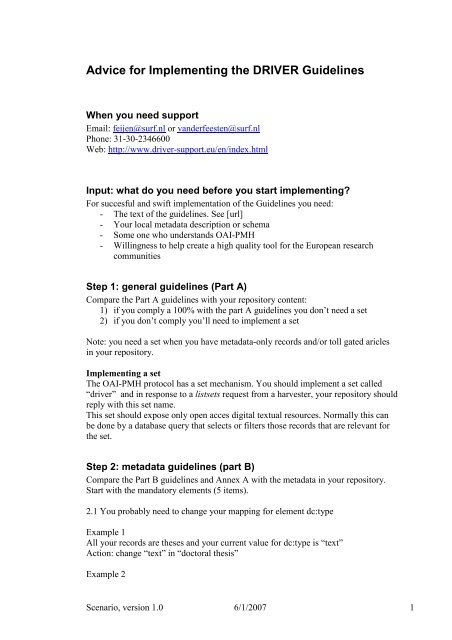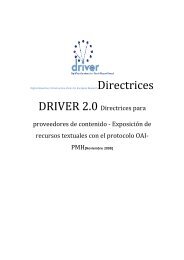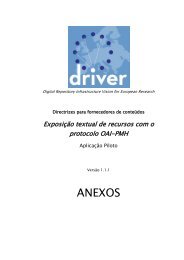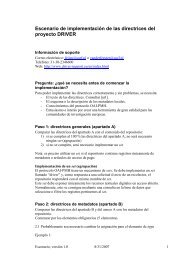Advice for Implementing the DRIVER Guidelines
Advice for Implementing the DRIVER Guidelines
Advice for Implementing the DRIVER Guidelines
Create successful ePaper yourself
Turn your PDF publications into a flip-book with our unique Google optimized e-Paper software.
<strong>Advice</strong> <strong>for</strong> <strong>Implementing</strong> <strong>the</strong> <strong>DRIVER</strong> <strong>Guidelines</strong><br />
When you need support<br />
Email: feijen@surf.nl or vanderfeesten@surf.nl<br />
Phone: 31-30-2346600<br />
Web: http://www.driver-support.eu/en/index.html<br />
Input: what do you need be<strong>for</strong>e you start implementing<br />
For succesful and swift implementation of <strong>the</strong> <strong>Guidelines</strong> you need:<br />
- The text of <strong>the</strong> guidelines. See [url]<br />
- Your local metadata description or schema<br />
- Some one who understands OAI-PMH<br />
- Willingness to help create a high quality tool <strong>for</strong> <strong>the</strong> European research<br />
communities<br />
Step 1: general guidelines (Part A)<br />
Compare <strong>the</strong> Part A guidelines with your repository content:<br />
1) if you comply a 100% with <strong>the</strong> part A guidelines you don’t need a set<br />
2) if you don’t comply you’ll need to implement a set<br />
Note: you need a set when you have metadata-only records and/or toll gated aricles<br />
in your repository.<br />
<strong>Implementing</strong> a set<br />
The OAI-PMH protocol has a set mechanism. You should implement a set called<br />
“driver” and in response to a listsets request from a harvester, your repository should<br />
reply with this set name.<br />
This set should expose only open acces digital textual resources. Normally this can<br />
be done by a database query that selects or filters those records that are relevant <strong>for</strong><br />
<strong>the</strong> set.<br />
Step 2: metadata guidelines (part B)<br />
Compare <strong>the</strong> Part B guidelines and Annex A with <strong>the</strong> metadata in your repository.<br />
Start with <strong>the</strong> mandatory elements (5 items).<br />
2.1 You probably need to change your mapping <strong>for</strong> element dc:type<br />
Example 1<br />
All your records are <strong>the</strong>ses and your current value <strong>for</strong> dc:type is “text”<br />
Action: change “text” in “doctoral <strong>the</strong>sis”<br />
Example 2<br />
Scenario, version 1.0 6/1/2007 1
You have articles, <strong>the</strong>ses and various o<strong>the</strong>r resources in your repository.<br />
Your current value is “text”<br />
Action: decide on your mapping or call <strong>the</strong> <strong>DRIVER</strong> helpdesk.<br />
2.2 You probably need to check dc:identifier<br />
Example 3<br />
You know that about 50% of your content has no dc:identifier or <strong>the</strong> element does<br />
not link to a digital files.<br />
Action: exclude <strong>the</strong>se records from <strong>the</strong> <strong>DRIVER</strong> set<br />
OR: insert links to digital files in this element<br />
Example 4<br />
Some links in your metadata records point to a digital that is not open access.<br />
Action: exclude <strong>the</strong>se records from <strong>the</strong> <strong>DRIVER</strong> set<br />
OR replace <strong>the</strong> link by a new one that points to an opan access file.<br />
2.3 Then proceed with <strong>the</strong> o<strong>the</strong>r elements of <strong>the</strong> metadata.<br />
Note <strong>the</strong> inverted name order <strong>for</strong> personal names.<br />
Use of abstracts in dc:description is encouraged.<br />
Do not place any url’s in any element o<strong>the</strong>r than dc:identifier.<br />
Example 5<br />
Your repository metadata is more detailed <strong>the</strong>n simple DC<br />
Action: dumb down to simple DC<br />
For any o<strong>the</strong>r questions or issues about metadata: call <strong>the</strong> helpdesk<br />
Step 3: OAI protocol guidelines<br />
Discuss <strong>the</strong> text of Part C and Annex 2 with a person who knows about OAI-PMH (it<br />
might be you). Note:<br />
- <strong>the</strong> optional didl metadata prefix<br />
- use of datestamp (important <strong>for</strong> incremental harvesting)<br />
- transient deletes in <strong>the</strong> Identify response<br />
- life of resumption token >5 hours<br />
- harvest batch size of 100-200 records<br />
- namespace declaration<br />
- correct xml encoding<br />
In general it doe snot take a lot of ef<strong>for</strong>t and time to comply to <strong>the</strong>se guidelines. Most<br />
IR software systems do allow <strong>for</strong> <strong>the</strong> parameter settings as described in <strong>the</strong>se<br />
<strong>Guidelines</strong>.<br />
But in case of doubt or problems call <strong>the</strong> helpdesk.<br />
Scenario, version 1.0 6/1/2007 2
We greatly encourage <strong>the</strong> use of <strong>the</strong> DIDL container (see Annex 3) Check with us or<br />
your systems developers be<strong>for</strong>e you start implementing it because we cooperate with<br />
systems developers in this area. Solutions already exist <strong>for</strong> Dspace, Arno and Vubis<br />
systems. It is expected <strong>the</strong>y will also become available <strong>for</strong> Opus, Eprints and HAL.<br />
Scenario, version 1.0 6/1/2007 3











